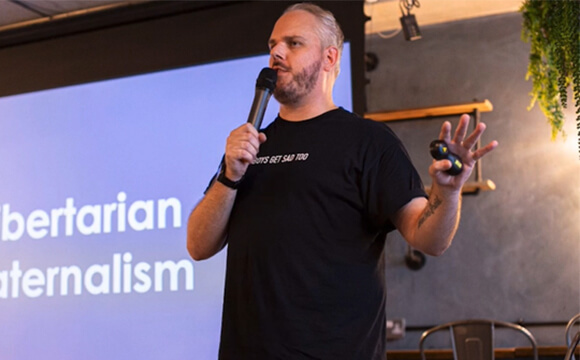How a benefits strategy can support a modern workplace, with Gethin Nadin

Ever been pleased to receive a gift card, then left it lying in a drawer, semi forgotten for months? A workplace benefits package is often a focus when we join an organisation, but like that Boots card from your aunt, it’s only a win-win for everyone if you can make the most of it.
With rising costs, labour shortages, pressure on wages, rising Covid rates and political upheaval, it’s never been more critical for employers to leave no stone unturned in the quest to maximise staff satisfaction, engagement and well-being. So, Audrey Robertson, Moorepay’s HR Consultancy and Insurance Manager, sat down with Gethin Nadin, Chief Innovation Officer at our sister company, Benefex, to find out more about the role a good benefits strategy can play in the modern workplace.
Audrey: Hi Gethin. I guess the first thing I wanted to understand better is what the advantage is of a benefits programme as opposed to, say, using the same budget to increase salaries. For lots of employees, especially right now, surely pay is the overwhelmingly most important thing?
Gethin: For the employer, I think in 2022 employee benefits are used for two primary purposes – to support and protect people from challenging life experiences, and to ensure employees are happy and healthy to give their best at work. For employees, benefit schemes are picking up the slack where traditional state support is failing.
Employee benefits help employees to get access to better and faster healthcare, to plan for later life, save for the future, insure against key life risks, and ease the financial burden of everyday living. Most employee benefit strategies are created and evolved with the idea of “how do I look after my people in the best way?”. Pay and benefits are two very different things – they shouldn’t be mutually exclusive. While pay is primarily designed to reward an individual for the work they put in, benefits are in place to support an employee’s life.
A recent survey by Glassdoor found that 79% of British employees would prefer new benefits to a pay rise. Even during the cost of living crisis, benefits can be used to ease financial stress and make net pay go further.
Pay and benefits are two very different things – they shouldn’t be mutually exclusive.
Do you think the main advantage for employers is the perceived value – typically a ‘nice to have’ at the back of the mind – or is there a step change when employees really engage with a benefits programme?
At Benefex we have on average very high engagement with benefit schemes. Most employees make at least one benefit choice each year. In many cases these benefits offer real, tangible life value. Whether that is protecting them against long term ill health, giving them access to healthcare professionals or helping them save for the future.
We have vast and compelling evidence that employee benefit schemes positively influence work attitude and commitment, motivation, productivity, retention and attraction, organisational outcomes, and employee engagement. The effect of benefits on the employee and employer is significant and well proven. And the pandemic has enhanced this further.
My impression is that in quite a lot of cases employees are superficially appreciative of a benefits programme but then don’t really use it to their full advantage – why do you think that is?
I think that really depends on the benefits on offer and the technology used. The best benefit scheme behind the worst technology will fail. The best technology with the wrong benefits will fail. The benefits we offer employees must be relevant, personalised and offer choice and flexibility so they move with an employee’s life stages. So, if driving an electric car is my priority this year, I can do that. But next year as I start a family, I may get more concerned with protecting my wellbeing and income, so I want the ability to switch out and add new benefits as my life evolves.
But making my benefit selections must be easy. I must be able to find, understand and select my benefits within a short space of time, wherever I am, whatever device I’m using and whatever time of day it is. As technology providers we must make benefit schemes attractive, with a great user experience so that we remove any points of friction to choosing a benefit. In many ways, it’s no different to how a retailer like Amazon makes sure it’s as easy as possible to find a product and checkout.
I can identify with that. Like most people, I am drawn to suppliers who let me solve my day to day problems in a few clicks, whether it’s a buying a takeaway or selling a house. Reviewing my pension savings used to be about writing letters and hanging on the phone for hours. Now it’s not much harder than checking email. What can employers do to drive benefit take-up rates by employees?
Communication is a key driver in a successful benefits scheme. People need reminding what benefits are available and how they can be used to support an employee’s life. In an age of information overload, employers need to be mindful that shorter bursts of regular benefit communications are the best way forward. Also linking benefits to what we know may be worrying employees. For example, using the cost-of-living crisis to show employees all the ways the benefits they have can help them save money.
So – for an employer who came to you with a fairly limited budget, what would be your top picks for the best benefits to offer?
Pretty consistently, among the most requested benefits are those that give an employee more time and more time away from work. So, holiday trading is up there with one of the most popular benefits. But post pandemic, we have also seen a huge trend in wellbeing related benefits. Globally, 8 of the top 10 benefits chosen last year were all wellbeing benefits. So those benefits that can move an employee away from NHS waiting lists, get them access to a healthcare expert quickly, that support the financial wellbeing of employees and insure them against key risks like disability and long-term ill health are proving to be the most popular.
But we are also seeing a huge trend in giving employees a pot of money that they can use to choose the benefits that are right for them. Some employers I work with are giving staff as little as £100 a year to spend, but allowing them to spend that on what they see fit within their benefit or wellbeing schemes.
Thanks Gethin – lots of food for thought there. What’s the best way for anyone reading this to find out more about Benefex and benefits in general?
You can find out more about Benefex on our website, including joining our webinars and exploring other resources where we explore topics like this – and many more – in depth. You can also find us on LinkedIn and Twitter.
So, what next?
We’ve discussed how the cost of living is impacting employees and their finances, and how benefits and discounts can help support this. Moorepay’s Benefits & Discounts Software integrates into our Payroll & HR Software to easily offset the demand for salary increases, improve financial wellbeing and compete with other businesses already offering an impressive line of perks.



